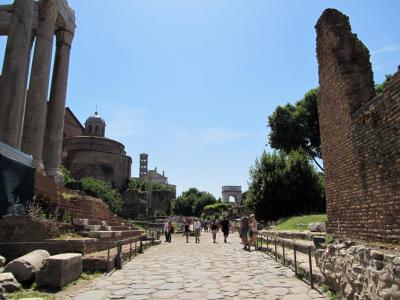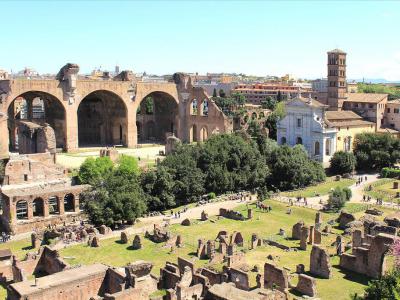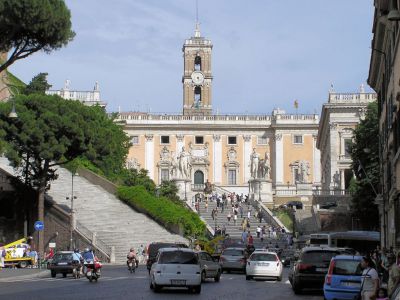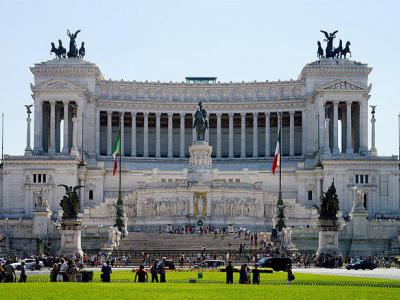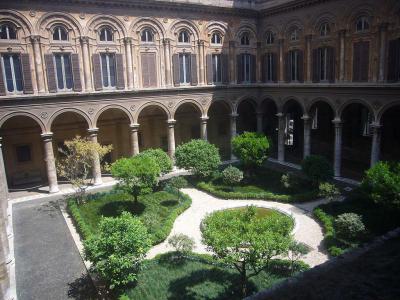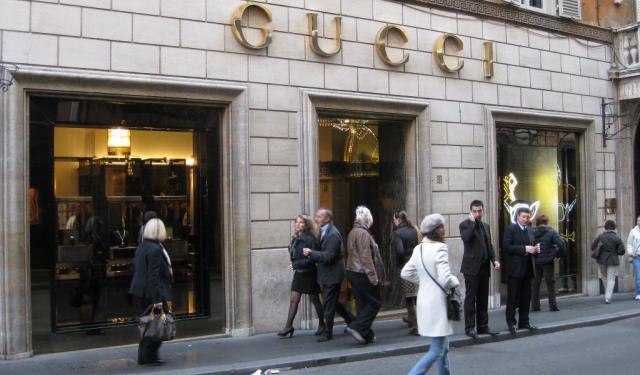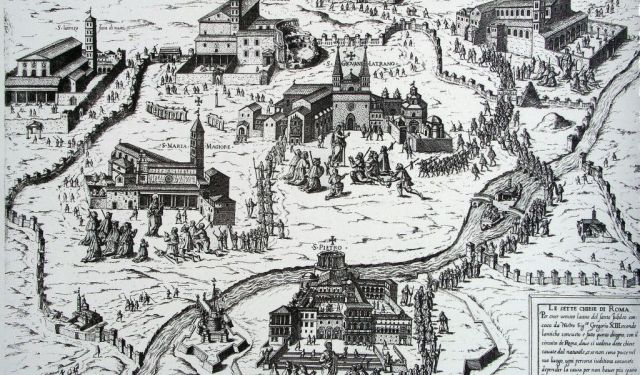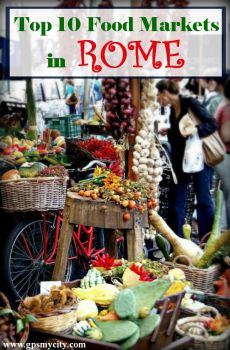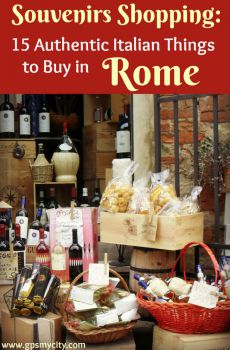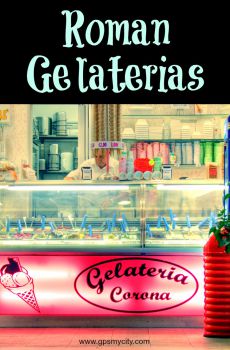Audio Guide: Rome Introduction Walking Tour I (Self Guided), Rome
Often referred to as the Eternal City, Rome holds a unique place in the story of Western civilization. Its influence shaped European culture through language, governance, and monumental architecture.
The name “Rome” originates from Romulus, the mythical founder of the city, who, according to legend, was the son of the war god Mars and Rhea Silvia, the priestess of goddess Vesta. Both Romulus and his twin brother Remus were found by a she-wolf in a cave. She suckled them until a shepherd rescued the two.
As adults, the brothers decided to establish a new town but quarreled over its location. In a heated debate that turned into a fight, Romulus killed Remus. He established the new town on the Palatine Hill, naming it after himself and reigning as its first king. The Hut of Romulus on the Palatine Hill attests to this legend.
Rome's history stretches back over 2,500 years, beginning as an Iron Age village in 753 BC. In 509 BC, the Romans overthrown its last king and established a republic led by two annually-elected consuls. This form of governance had a profound influence on how modern-day governments function.
Over the centuries, Rome grew from a struggling city-state to the capital of the mighty empire, which dominated the Mediterranean by the 1st century AD. Between the 6th and 9th centuries, Latin, the dominant tongue of the Roman Empire, evolved into distinct Romance languages. Most European languages today either trace their roots directly to or are heavily influenced by Latin.
After the Roman Empire's fall in 476 AD, the city declined but rebounded during the Renaissance and Baroque periods, becoming a hub for artistic achievements. In 1870, Rome was declared the capital of unified Italy, cementing its legacy as a cultural and historical powerhouse.
The Colosseum, built in 70-80 AD, symbolizes Rome’s grandeur as the Roman Empire’s largest amphitheater. The Roman Forum still in place was once the city’s political and commercial heart, while the Imperial Forums reflect the architectural ambitions of its emperors. The Capitoline Museums, atop Michelangelo-designed Capitoline Hill, house remarkable artifacts. Nearby, the Victor Emmanuel II Monument celebrates Italy’s unification. Art enthusiasts can explore masterpieces at the Doria Pamphilj Gallery, and Trevi Fountain beckons visitors to toss a coin, promising their return.
Rome is a city where every corner tells a story, blending myth and history, the ancient and the modern. A visit here offers an endless journey of discovery. So come and immerse yourself in the Eternal City, where the past and present live in perfect harmony.
The name “Rome” originates from Romulus, the mythical founder of the city, who, according to legend, was the son of the war god Mars and Rhea Silvia, the priestess of goddess Vesta. Both Romulus and his twin brother Remus were found by a she-wolf in a cave. She suckled them until a shepherd rescued the two.
As adults, the brothers decided to establish a new town but quarreled over its location. In a heated debate that turned into a fight, Romulus killed Remus. He established the new town on the Palatine Hill, naming it after himself and reigning as its first king. The Hut of Romulus on the Palatine Hill attests to this legend.
Rome's history stretches back over 2,500 years, beginning as an Iron Age village in 753 BC. In 509 BC, the Romans overthrown its last king and established a republic led by two annually-elected consuls. This form of governance had a profound influence on how modern-day governments function.
Over the centuries, Rome grew from a struggling city-state to the capital of the mighty empire, which dominated the Mediterranean by the 1st century AD. Between the 6th and 9th centuries, Latin, the dominant tongue of the Roman Empire, evolved into distinct Romance languages. Most European languages today either trace their roots directly to or are heavily influenced by Latin.
After the Roman Empire's fall in 476 AD, the city declined but rebounded during the Renaissance and Baroque periods, becoming a hub for artistic achievements. In 1870, Rome was declared the capital of unified Italy, cementing its legacy as a cultural and historical powerhouse.
The Colosseum, built in 70-80 AD, symbolizes Rome’s grandeur as the Roman Empire’s largest amphitheater. The Roman Forum still in place was once the city’s political and commercial heart, while the Imperial Forums reflect the architectural ambitions of its emperors. The Capitoline Museums, atop Michelangelo-designed Capitoline Hill, house remarkable artifacts. Nearby, the Victor Emmanuel II Monument celebrates Italy’s unification. Art enthusiasts can explore masterpieces at the Doria Pamphilj Gallery, and Trevi Fountain beckons visitors to toss a coin, promising their return.
Rome is a city where every corner tells a story, blending myth and history, the ancient and the modern. A visit here offers an endless journey of discovery. So come and immerse yourself in the Eternal City, where the past and present live in perfect harmony.
How it works: Download the app "GPSmyCity: Walks in 1K+ Cities" from Apple App Store or Google Play Store to your mobile phone or tablet. The app turns your mobile device into a personal tour guide and its built-in GPS navigation functions guide you from one tour stop to next. The app works offline, so no data plan is needed when traveling abroad.
Rome Introduction Walking Tour I Map
Guide Name: Rome Introduction Walking Tour I
Guide Location: Italy » Rome (See other walking tours in Rome)
Guide Type: Self-guided Walking Tour (Sightseeing)
# of Attractions: 11
Tour Duration: 2 Hour(s)
Travel Distance: 3.7 Km or 2.3 Miles
Author: DanaOffice
Sight(s) Featured in This Guide:
Guide Location: Italy » Rome (See other walking tours in Rome)
Guide Type: Self-guided Walking Tour (Sightseeing)
# of Attractions: 11
Tour Duration: 2 Hour(s)
Travel Distance: 3.7 Km or 2.3 Miles
Author: DanaOffice
Sight(s) Featured in This Guide:
- Colosseo (Colosseum)
- Arco di Costantino (Arch of Constantine)
- Via Sacra (Sacred Street)
- Palatino (Palatine Hill)
- Foro Romano (Roman Forum)
- Fori Imperiali (Imperial Forums)
- Musei Capitolini (Capitoline Museums)
- Campidoglio (Capitoline Hill)
- Vittoriano (Victor Emmanuel II National Monument)
- Galleria Doria Pamphilj (Doria Pamphilj Gallery)
- Piazza di Trevi & Fontana di Trevi (Trevi Square & Trevi Fountain)
1) Colosseo (Colosseum) (must see)
The Colosseum, Rome’s iconic elliptical amphitheater, is the largest ancient amphitheater ever built, covering 24,000 square meters. Constructed between 69 and 80 AD by the Flavian dynasty, it was initially called the Flavian Amphitheater. Its modern name stems from the Colossus of Nero statue that once stood nearby, with the term "Colosseum" emerging during the medieval period.
Built on the land reclaimed from Emperor Nero’s landscaped Domus Aurea complex after the Great Fire of 64 AD, the Colosseum represented a gift to the Roman people under Emperor Vespasian. It was constructed using travertine, tuff, and concrete and was funded by spoils from the Jewish War. The latter, fought in 70 AD, led to the Siege of Jerusalem and brought back numerous prisoners who largely contributed to the massive workforce needed for the construction. The amphitheater comprised four tiers that could hold between 50,000 and 80,000 spectators at a time. Its free-standing structure features three architectural orders – Doric, Ionic, and Corinthian.
The lowest tier was for the emperor and the royal family, the two middle ones were for the noble Romans and members of government, while the highest tier was for the ordinary citizens. The elaborate system included 80 entrances, passageways for crowd control, and numbered pottery tickets for seating. Admission was free and the main sponsor was the emperor himself.
The Colosseum hosted gladiatorial contests, animal hunts, and mythological reenactments. Events often featured exotic animals imported from Africa and the Middle East. Emperor Trajan's games, for example, involved over 11,000 animals and 10,000 gladiators over 123 days! The below-ground passages were used to bring men and animals into the arena, which was separated from the audience by a ditch. Occasionally, it was reportedly even flooded for naval battles. Executions were common during intervals, with the condemned facing wild beasts or acting out tragic myths.
During the medieval period, the Colosseum served as a fortress and even a stone quarry. Passers-by habitually chipped off pieces of it for souvenirs which, together with some natural causes like earthquakes, led to its partial destruction.
Despite popular belief that the early Christians were martyred here in numbers, evidence suggests that most executions occurred elsewhere. By the 17th century, the Colosseum became recognized as a sacred site. Today, it hosts the Pope’s Good Friday “Way of the Cross” procession.
Only the north side of the building, as well as the underground passages, have survived intact. The arena floor is totally gone. Inside the Colosseum, there's a historical exhibition with both permanent and changing displays.
Tips:
Visit early in the morning or late in the evening to avoid long queues and heat. The ground and first floors are open to visitors without a special ticket, while the subterranean part and the third floor are accessed on pre-booked tours only. Opt for a guided tour to skip lines and access the Forum area. Alternatively, buy tickets in advance or at the Roman Forum. Enhance your experience with an audio guide for detailed historical insights.
Built on the land reclaimed from Emperor Nero’s landscaped Domus Aurea complex after the Great Fire of 64 AD, the Colosseum represented a gift to the Roman people under Emperor Vespasian. It was constructed using travertine, tuff, and concrete and was funded by spoils from the Jewish War. The latter, fought in 70 AD, led to the Siege of Jerusalem and brought back numerous prisoners who largely contributed to the massive workforce needed for the construction. The amphitheater comprised four tiers that could hold between 50,000 and 80,000 spectators at a time. Its free-standing structure features three architectural orders – Doric, Ionic, and Corinthian.
The lowest tier was for the emperor and the royal family, the two middle ones were for the noble Romans and members of government, while the highest tier was for the ordinary citizens. The elaborate system included 80 entrances, passageways for crowd control, and numbered pottery tickets for seating. Admission was free and the main sponsor was the emperor himself.
The Colosseum hosted gladiatorial contests, animal hunts, and mythological reenactments. Events often featured exotic animals imported from Africa and the Middle East. Emperor Trajan's games, for example, involved over 11,000 animals and 10,000 gladiators over 123 days! The below-ground passages were used to bring men and animals into the arena, which was separated from the audience by a ditch. Occasionally, it was reportedly even flooded for naval battles. Executions were common during intervals, with the condemned facing wild beasts or acting out tragic myths.
During the medieval period, the Colosseum served as a fortress and even a stone quarry. Passers-by habitually chipped off pieces of it for souvenirs which, together with some natural causes like earthquakes, led to its partial destruction.
Despite popular belief that the early Christians were martyred here in numbers, evidence suggests that most executions occurred elsewhere. By the 17th century, the Colosseum became recognized as a sacred site. Today, it hosts the Pope’s Good Friday “Way of the Cross” procession.
Only the north side of the building, as well as the underground passages, have survived intact. The arena floor is totally gone. Inside the Colosseum, there's a historical exhibition with both permanent and changing displays.
Tips:
Visit early in the morning or late in the evening to avoid long queues and heat. The ground and first floors are open to visitors without a special ticket, while the subterranean part and the third floor are accessed on pre-booked tours only. Opt for a guided tour to skip lines and access the Forum area. Alternatively, buy tickets in advance or at the Roman Forum. Enhance your experience with an audio guide for detailed historical insights.
2) Arco di Costantino (Arch of Constantine)
On October 28, 312 AD, Roman emperor Constantine had an epic battle with his rival, co-emperor Maxentius. It went down in history as the Battle of the Milvian Bridge. Victorious Constantine became the sole ruler of the Roman Empire, thus ending the system of Tetrarchy. He is generally regarded as the last great emperor of Rome.
The Arch of Constantine, Rome’s largest triumphal arch, was dedicated in 315 AD to commemorate Constantine’s victory. Located between the Colosseum and Palatine Hill, it spans the Road of Triumph, marking the route of Roman military parades. The arch stands 21 meters high, featuring three bays and incorporating elements from earlier monuments, including reliefs and statues from the reigns of Trajan, Hadrian, and Marcus Aurelius, reworked to celebrate Constantine.
Scholars have debated the arch's origins, suggesting it may predate Constantine and even have ties to Hadrian’s or Maxentius’s reigns. The arch exemplifies Late Antique artistic styles, with a blend of reused classical Greek-inspired elements and newly-created simpler, symbolic works. Reliefs from earlier monuments display classical proportions and dynamic movement, while the 4th-century additions feature rigid and geometric forms, reflecting changes in artistic priorities or economic constraints at that time. This stylistic contrast highlights the transition from Rome’s classical tradition to the evolving aesthetics of Late Antiquity.
Decorative elements on the arch include reliefs of Dacians from Trajan’s reign, panels depicting Marcus Aurelius’s military campaigns, and roundels from Hadrian’s era reworked to depict Constantine. A Constantinian frieze narrates his campaign against Maxentius, while inscriptions celebrate him as a pious and victorious leader.
One such inscription credits Constantine with saving the Roman people by divine inspiration. It refers to his vision before the Battle of Milvian Bridge in 312 AD, where he claimed to have seen a cross in the sky and heard the words: "In this sign, you will conquer." This event is often linked to Constantine's promotion of Christianity within the Roman Empire. The arch also balances pagan and Christian themes, symbolizing Constantine’s shifting religious stance during this period.
The Arch of Constantine's global influence as a monument includes the likes of the Arch of Triumph in Paris, the Marble Arch in London, Washington Union Station in Washington DC, and the American Museum of Natural History in New York City.
The Arch of Constantine, Rome’s largest triumphal arch, was dedicated in 315 AD to commemorate Constantine’s victory. Located between the Colosseum and Palatine Hill, it spans the Road of Triumph, marking the route of Roman military parades. The arch stands 21 meters high, featuring three bays and incorporating elements from earlier monuments, including reliefs and statues from the reigns of Trajan, Hadrian, and Marcus Aurelius, reworked to celebrate Constantine.
Scholars have debated the arch's origins, suggesting it may predate Constantine and even have ties to Hadrian’s or Maxentius’s reigns. The arch exemplifies Late Antique artistic styles, with a blend of reused classical Greek-inspired elements and newly-created simpler, symbolic works. Reliefs from earlier monuments display classical proportions and dynamic movement, while the 4th-century additions feature rigid and geometric forms, reflecting changes in artistic priorities or economic constraints at that time. This stylistic contrast highlights the transition from Rome’s classical tradition to the evolving aesthetics of Late Antiquity.
Decorative elements on the arch include reliefs of Dacians from Trajan’s reign, panels depicting Marcus Aurelius’s military campaigns, and roundels from Hadrian’s era reworked to depict Constantine. A Constantinian frieze narrates his campaign against Maxentius, while inscriptions celebrate him as a pious and victorious leader.
One such inscription credits Constantine with saving the Roman people by divine inspiration. It refers to his vision before the Battle of Milvian Bridge in 312 AD, where he claimed to have seen a cross in the sky and heard the words: "In this sign, you will conquer." This event is often linked to Constantine's promotion of Christianity within the Roman Empire. The arch also balances pagan and Christian themes, symbolizing Constantine’s shifting religious stance during this period.
The Arch of Constantine's global influence as a monument includes the likes of the Arch of Triumph in Paris, the Marble Arch in London, Washington Union Station in Washington DC, and the American Museum of Natural History in New York City.
3) Via Sacra (Sacred Street)
The Sacred Street, once the main ceremonial and religious road in ancient Rome, dates back to the city's regal age. It used to link key settlements, such as Velia, to major landmarks like the Roman Forum and Capitoline Hill. As Rome grew, the street became central to both political and religious activities, passing through significant sites such as the Regia, one of the oldest buildings in the Forum, and the Comitium, the city's political hub.
The name “Sacred” derives from its association with sacred events, including the peace treaty which united the Romans and Sabines under a dual kingship of Romulus and Titus Tatius. Over time, the road was paved and modified, becoming the primary route for triumphal processions celebrating military victories. These parades, which frequently followed Roman conquests, moved through the Arch of Titus and concluded at the Arch of Septimius Severus.
As the street’s importance grew, it underwent improvements, including the addition of colonnades and other architectural enhancements. The Arch of Titus was among these significant upgrades. Over the centuries, the Sacred Street evolved from a residential area, where noble families once lived, into a monumental corridor lined with structures like the Basilica of Maxentius, the Temple of Venus and Roma, and the Temple of Peace. Its proximity to early Christian churches underscored its continued religious significance even as Rome transitioned into the imperial era.
Following the Great Fire of Rome in 64 AD, Nero redirected and straightened the eastern stretch of the street, adding colonnades and commercial spaces, effectively transforming it into a grand boulevard. In this capacity, the road was a stage for everyday Roman life, hosting solemn festivals, public gatherings, business dealings, and even prostitution.
Since the reign of Augustus, the first Roman emperor, it became part of the apotheosis ceremonies for deceased rulers; their bodies were carried along the street to the Forum for public tributes.
Visitors can still see wear and tear from Roman times on the Sacred Street's pavers, including smooth surfaces and wagon-wheel crevices. As such, it's a must-see highlight of the Roman Forum, offering a tangible connection to Rome’s ancient grandeur.
The name “Sacred” derives from its association with sacred events, including the peace treaty which united the Romans and Sabines under a dual kingship of Romulus and Titus Tatius. Over time, the road was paved and modified, becoming the primary route for triumphal processions celebrating military victories. These parades, which frequently followed Roman conquests, moved through the Arch of Titus and concluded at the Arch of Septimius Severus.
As the street’s importance grew, it underwent improvements, including the addition of colonnades and other architectural enhancements. The Arch of Titus was among these significant upgrades. Over the centuries, the Sacred Street evolved from a residential area, where noble families once lived, into a monumental corridor lined with structures like the Basilica of Maxentius, the Temple of Venus and Roma, and the Temple of Peace. Its proximity to early Christian churches underscored its continued religious significance even as Rome transitioned into the imperial era.
Following the Great Fire of Rome in 64 AD, Nero redirected and straightened the eastern stretch of the street, adding colonnades and commercial spaces, effectively transforming it into a grand boulevard. In this capacity, the road was a stage for everyday Roman life, hosting solemn festivals, public gatherings, business dealings, and even prostitution.
Since the reign of Augustus, the first Roman emperor, it became part of the apotheosis ceremonies for deceased rulers; their bodies were carried along the street to the Forum for public tributes.
Visitors can still see wear and tear from Roman times on the Sacred Street's pavers, including smooth surfaces and wagon-wheel crevices. As such, it's a must-see highlight of the Roman Forum, offering a tangible connection to Rome’s ancient grandeur.
4) Palatino (Palatine Hill) (must see)
The Palatine Hill, centrally located among Rome’s seven hills, is one of the city’s oldest and most historically significant areas. Often referred to as "the first nucleus of the Roman Empire," it is now a vast open-air museum.
Overlooking the Roman Forum and Circus Maximus, Palatine Hill became the desirable location for the homes of Rome's wealthiest citizens during the Republican era. During the Imperial era, starting from the reign of Augustus, it was an exclusive domain of emperors, featuring luxurious palaces like those of Augustus, Tiberius, and Domitian. Before imperial development, the hill had two summits, Palatium and Germalus, separated by a depression. Over time, the Palatine played a central role in Rome’s evolution, with continuous habitation traced back to the 10th century BC. Excavations reveal funerary huts from the 9th–7th centuries BC, aligning with the city’s mythological founding period.
The modern-day word “palace” is derived from the word “Palatine”.
Roman mythology enriches its legacy, as the hill was believed to be the site where Rome was reportedly founded. According to legend, it was on this hill that the twins Romulus and Remus, the legendary founders of Rome, were discovered by a she-wolf who raised them. When they grew up, the twins set out to build a city of their own. While Remus wanted to build it on Aventine Hill, Romulus had his mind set firmly on Palatine Hill. The brothers argued fiercely, and during the fight, Romulus killed Remus. He went on to build the city in 753 BC, calling it Rome, and reigned as its first king.
Monumental structures dominate the site, including the Palace of Domitian and the House of Livia, the latter renowned for its well-preserved frescoes. The House of Tiberius partially survives within the Farnese Gardens.
Extensive archaeological excavations, dating back to Augustus’ time, have uncovered significant finds, including Bronze Age artifacts and the Palatine House, thought to be the birthplace of Emperor Augustus. Modern investigations have revealed frescoed walls and mosaics, along with the Lupercal, the cave at the southwest foot of the Palatine Hill, where Romulus and Remus were suckled by the she-wolf.
Tip:
"Super" tickets provide access to the key attractions on the Hill, including the Roman Forum and Colosseum. Prepare with water, snacks, sunscreen, a hat, and sturdy shoes, as the steep paths and lack of vending machines can be challenging.
Overlooking the Roman Forum and Circus Maximus, Palatine Hill became the desirable location for the homes of Rome's wealthiest citizens during the Republican era. During the Imperial era, starting from the reign of Augustus, it was an exclusive domain of emperors, featuring luxurious palaces like those of Augustus, Tiberius, and Domitian. Before imperial development, the hill had two summits, Palatium and Germalus, separated by a depression. Over time, the Palatine played a central role in Rome’s evolution, with continuous habitation traced back to the 10th century BC. Excavations reveal funerary huts from the 9th–7th centuries BC, aligning with the city’s mythological founding period.
The modern-day word “palace” is derived from the word “Palatine”.
Roman mythology enriches its legacy, as the hill was believed to be the site where Rome was reportedly founded. According to legend, it was on this hill that the twins Romulus and Remus, the legendary founders of Rome, were discovered by a she-wolf who raised them. When they grew up, the twins set out to build a city of their own. While Remus wanted to build it on Aventine Hill, Romulus had his mind set firmly on Palatine Hill. The brothers argued fiercely, and during the fight, Romulus killed Remus. He went on to build the city in 753 BC, calling it Rome, and reigned as its first king.
Monumental structures dominate the site, including the Palace of Domitian and the House of Livia, the latter renowned for its well-preserved frescoes. The House of Tiberius partially survives within the Farnese Gardens.
Extensive archaeological excavations, dating back to Augustus’ time, have uncovered significant finds, including Bronze Age artifacts and the Palatine House, thought to be the birthplace of Emperor Augustus. Modern investigations have revealed frescoed walls and mosaics, along with the Lupercal, the cave at the southwest foot of the Palatine Hill, where Romulus and Remus were suckled by the she-wolf.
Tip:
"Super" tickets provide access to the key attractions on the Hill, including the Roman Forum and Colosseum. Prepare with water, snacks, sunscreen, a hat, and sturdy shoes, as the steep paths and lack of vending machines can be challenging.
5) Foro Romano (Roman Forum) (must see)
The Roman Forum, once the pulsating heart of ancient Rome's public life, evolved from a simple marketplace around 500 BC into the epicenter of Roman political, social, and religious activity. Known as the Forum Magnum, it became a hub for triumphal processions, public speeches, elections, criminal trials, gladiatorial matches, and commerce. Statues and monuments celebrating Roman leaders solidified its status as one of history’s most significant meeting places.
Initially featuring early structures like the Regia (a royal residence) and the Temple of Vesta, the Forum developed into a formal assembly area called the Comitium, where the Senate and government convened. Over centuries, temples, tribunals, and public buildings, such as the Senate House and the Temple of Saturn, transformed the Forum into a multifunctional hub. The Basilica Aemilia, built in 179 BC, expanded judicial activities, while Julius Caesar’s enhancements, including the Basilica Julia and Curia Julia, underscored its role as a center for politics, commerce, and religion.
Despite its prominence, the Forum’s importance began to decline with the emergence of grander structures, such as Trajan's Forum and the Basilica Ulpia, to the north. Unlike the more planned Imperial Forums, the Roman Forum grew organically, reflecting a mix of architectural styles across periods. Constantine the Great’s construction of the Maxentius Basilica in 312 AD marked its final significant addition, temporarily restoring its political centrality. However, the fall of the Western Roman Empire in the 5th century AD led to the Forum's destruction and decline.
Today, the Roman Forum is a sprawling ruin but remains a priceless historical treasure. Though reduced to crumbling remains, it continues to captivate visitors, drawing nearly five million annually. Highlights of the site include the Sacred Street, the Arch of Titus, and remnants of iconic buildings like the Temple of Castor and Pollux.
Initially featuring early structures like the Regia (a royal residence) and the Temple of Vesta, the Forum developed into a formal assembly area called the Comitium, where the Senate and government convened. Over centuries, temples, tribunals, and public buildings, such as the Senate House and the Temple of Saturn, transformed the Forum into a multifunctional hub. The Basilica Aemilia, built in 179 BC, expanded judicial activities, while Julius Caesar’s enhancements, including the Basilica Julia and Curia Julia, underscored its role as a center for politics, commerce, and religion.
Despite its prominence, the Forum’s importance began to decline with the emergence of grander structures, such as Trajan's Forum and the Basilica Ulpia, to the north. Unlike the more planned Imperial Forums, the Roman Forum grew organically, reflecting a mix of architectural styles across periods. Constantine the Great’s construction of the Maxentius Basilica in 312 AD marked its final significant addition, temporarily restoring its political centrality. However, the fall of the Western Roman Empire in the 5th century AD led to the Forum's destruction and decline.
Today, the Roman Forum is a sprawling ruin but remains a priceless historical treasure. Though reduced to crumbling remains, it continues to captivate visitors, drawing nearly five million annually. Highlights of the site include the Sacred Street, the Arch of Titus, and remnants of iconic buildings like the Temple of Castor and Pollux.
6) Fori Imperiali (Imperial Forums)
The Imperial Forums are a series of monumental public squares in Rome that once served as centers of politics, religion, and economy during the Roman Republic and Empire. Located near the Roman Forum, these squares were built over about 150 years, between the mid-1st century BC and the early 2nd century AD. It began with Julius Caesar, who restructured the area to establish the Forum of Caesar. This forum, inaugurated in 46 BC, celebrated his power and included a temple to Venus Genetrix, symbolizing his divine lineage.
Emperor Augustus followed with the Forum of Augustus, inaugurated in 2 BC after decades of construction. It featured the Temple of Mars Ultor, honoring his victory at Philippi and his connection to Rome's mythological founding through Mars. The forum's layout included semicircular exedrae, long porticos, and a fire-resistant wall separating it from the Suburra district.
Emperor Vespasian, in turn, constructed the Temple of Peace, otherwise known as the Forum of Vespasian, in 75 AD, to commemorate the conquest of Jerusalem. Unlike other forums, it served as a garden and open-air museum, featuring pools, statues, and the Forma Urbis Romae, a marble map of ancient Rome.
The Forum of Nerva, initiated by Domitian and completed by his successor, was a smaller transitional forum connecting the earlier complexes. It included a monumental entrance and a temple dedicated to Minerva, symbolizing protection for the emperor.
The Forum of Trajan, completed in 113 AD, was the largest and most elaborate. Built to commemorate Trajan’s victory in Dacia, its design required significant reshaping of the Quirinal Hill. It featured the Basilica Ulpia, Trajan's Column, and a massive equestrian statue of the emperor.
During the 1930s, Mussolini restored the Imperial Forums in an effort to evoke and emulate the past glories of Ancient Rome. He also built a road crossing through the site, supposedly in a bid to make the Colosseum visible from his office window.
A museum at Trajan’s Market, opened in 2007, showcases the history and significance of these forums through artifacts, models, and exhibits, preserving the legacy of Rome's monumental past. Although only a fraction of the original structures remain, the ruins of the Imperial Forums still convey the scale and grandeur of the ancient city. In recent years, the Imperial Forums avenue has been made traffic-free, so walking on it, with just a little imagination, will give you a pretty good sense of Ancient Rome's magnitude.
Emperor Augustus followed with the Forum of Augustus, inaugurated in 2 BC after decades of construction. It featured the Temple of Mars Ultor, honoring his victory at Philippi and his connection to Rome's mythological founding through Mars. The forum's layout included semicircular exedrae, long porticos, and a fire-resistant wall separating it from the Suburra district.
Emperor Vespasian, in turn, constructed the Temple of Peace, otherwise known as the Forum of Vespasian, in 75 AD, to commemorate the conquest of Jerusalem. Unlike other forums, it served as a garden and open-air museum, featuring pools, statues, and the Forma Urbis Romae, a marble map of ancient Rome.
The Forum of Nerva, initiated by Domitian and completed by his successor, was a smaller transitional forum connecting the earlier complexes. It included a monumental entrance and a temple dedicated to Minerva, symbolizing protection for the emperor.
The Forum of Trajan, completed in 113 AD, was the largest and most elaborate. Built to commemorate Trajan’s victory in Dacia, its design required significant reshaping of the Quirinal Hill. It featured the Basilica Ulpia, Trajan's Column, and a massive equestrian statue of the emperor.
During the 1930s, Mussolini restored the Imperial Forums in an effort to evoke and emulate the past glories of Ancient Rome. He also built a road crossing through the site, supposedly in a bid to make the Colosseum visible from his office window.
A museum at Trajan’s Market, opened in 2007, showcases the history and significance of these forums through artifacts, models, and exhibits, preserving the legacy of Rome's monumental past. Although only a fraction of the original structures remain, the ruins of the Imperial Forums still convey the scale and grandeur of the ancient city. In recent years, the Imperial Forums avenue has been made traffic-free, so walking on it, with just a little imagination, will give you a pretty good sense of Ancient Rome's magnitude.
7) Musei Capitolini (Capitoline Museums) (must see)
The Capitoline Museums in Rome are among the city's most prestigious art and archaeology institutions, second in prominence only to the Vatican Museums. Established in 1471 by Pope Sixtus IV, who donated significant bronze sculptures to the city, it is recognized as the world's oldest public museum. Designed by Michelangelo in 1536, the museum spans two main buildings: the Conservators' Palace and the New Palace, housing artifacts from ancient, medieval, and Renaissance periods.
Significant expansions occurred in 1734 under Pope Clement XII, who added Cardinal Albani’s antiquities to prevent their export. Rodolfo Lanciani’s 19th-century reorganization emphasized the archaeological context. The collection now covers nearly 13,000 square meters and includes modern additions such as the Central Montemartini branch and the Exedra of Marcus Aurelius.
Local highlights include the Equestrian Statue of Marcus Aurelius, moved indoors in 1990 (its place in the square is now taken by a replica), and the iconic Capitoline Wolf, a bronze sculpture potentially dating to the 5th century BC or the medieval period. The Colossus of Constantine, the Hercules of the Forum Boarium, and the Boy with Thorn are among other bronze masterpieces found here. Also noteworthy are The Dying Gaul and Arnolfo di Cambio’s Portrait of Charles I of Anjou made in the 13th century, Europe’s earliest lifelike portrait of a living figure.
Historical artifacts include the Protomoteca, busts relocated from the Pantheon, and the Conaccordo Gallery, which connects the palaces and leads to the Tabularium and the Temple of Veiovis. The Conservators' Palace features the Hall of the Horatii and Curiatii with 16th-century frescoes, and the Pinacoteca Capitolina which displays Renaissance works by Caravaggio, Titian, and Tintoretto. Its corridor showcases an Epigraphic Collection, while a staircase leading to the Tabularium gallery affords breathtaking views of the Roman Forum.
With a full-day ticket, visitors can leisurely explore both palaces, culminating in a panoramic view of ancient Rome.
The Capitoline Museums also hold historical significance as the venue where the 1957 Treaties of Rome, a cornerstone of the European Union, were signed.
Tip:
The Terrazza Caffarelli café atop the Capitoline Museums offers stunning panoramic views of Rome's rooftops and ancient ruins, especially at sunset. Enjoy excellent coffee, cakes, or an aperitivo with snacks. Accessible via Piazzale Caffarelli, the café welcomes all, even those without museum admission, for a memorable culinary and scenic experience.
Significant expansions occurred in 1734 under Pope Clement XII, who added Cardinal Albani’s antiquities to prevent their export. Rodolfo Lanciani’s 19th-century reorganization emphasized the archaeological context. The collection now covers nearly 13,000 square meters and includes modern additions such as the Central Montemartini branch and the Exedra of Marcus Aurelius.
Local highlights include the Equestrian Statue of Marcus Aurelius, moved indoors in 1990 (its place in the square is now taken by a replica), and the iconic Capitoline Wolf, a bronze sculpture potentially dating to the 5th century BC or the medieval period. The Colossus of Constantine, the Hercules of the Forum Boarium, and the Boy with Thorn are among other bronze masterpieces found here. Also noteworthy are The Dying Gaul and Arnolfo di Cambio’s Portrait of Charles I of Anjou made in the 13th century, Europe’s earliest lifelike portrait of a living figure.
Historical artifacts include the Protomoteca, busts relocated from the Pantheon, and the Conaccordo Gallery, which connects the palaces and leads to the Tabularium and the Temple of Veiovis. The Conservators' Palace features the Hall of the Horatii and Curiatii with 16th-century frescoes, and the Pinacoteca Capitolina which displays Renaissance works by Caravaggio, Titian, and Tintoretto. Its corridor showcases an Epigraphic Collection, while a staircase leading to the Tabularium gallery affords breathtaking views of the Roman Forum.
With a full-day ticket, visitors can leisurely explore both palaces, culminating in a panoramic view of ancient Rome.
The Capitoline Museums also hold historical significance as the venue where the 1957 Treaties of Rome, a cornerstone of the European Union, were signed.
Tip:
The Terrazza Caffarelli café atop the Capitoline Museums offers stunning panoramic views of Rome's rooftops and ancient ruins, especially at sunset. Enjoy excellent coffee, cakes, or an aperitivo with snacks. Accessible via Piazzale Caffarelli, the café welcomes all, even those without museum admission, for a memorable culinary and scenic experience.
8) Campidoglio (Capitoline Hill)
The Capitoline Hill, one of Rome’s Seven Hills, holds a storied past rooted in both mythology and history. Originally called Mount Saturn and dedicated to the Roman god Saturn, the hill later gained the name “Capitolium,” initially referring to the Temple of Jupiter Optimus Maximus. A myth ties its name to caput ("head") after a human skull was unearthed during the temple’s construction. The hill, symbolizing indestructibility and eternity, inspired the term “capitol,” eventually influencing sites like Capitol Hill in Washington, D.C.
Historically, the Capitoline served as a sacred and civic center. It withstood the Gaulish invasion of 390 BC and witnessed key events such as Julius Caesar’s penance and the destructive fire during the Year of Four Emperors (69 AD). By the Middle Ages, the hill evolved into a governance hub under papal authority. Its transformation was completed in the Renaissance when Michelangelo redesigned it into a civic landmark.
Michelangelo’s Capitol Square, commissioned by Pope Paul III between 1536 and 1546, reoriented the hill from the Roman Forum toward Saint Peter’s Basilica, reflecting a shift to Christian symbolism. Central to the square is the equestrian statue of Marcus Aurelius, believed to represent Emperor Constantine. The square features intricate paving with cosmic motifs, though this element was added in 1940.
The square is surrounded by three palaces. The Conservators' Palace, renovated by Michelangelo in the 16th century, incorporates colossal Corinthian pilasters, while the New Palace, built in the 17th century, mirrors its design. The 14th-century Senatorial Palace, atop the ancient Tabularium, serves as city hall, with Michelangelo’s double staircase integrating it seamlessly into the plaza. Accessed by the cordonata, a wide gradual ramp flanked by the statues of Castor and Pollux (the twin half-brothers in Greek and Roman mythology), the hill exemplifies Renaissance grandeur.
Tips:
For a memorable experience, be sure to enjoy the amazing views of the city and the Roman Forum from both the museums' plaza and the Vittorio Emanuele II Monument, particularly from its top accessible via the elevator. Keep in mind that dedicating at least half a day is recommended, as there are numerous magnificent buildings and squares located behind the rear of the main building.
Historically, the Capitoline served as a sacred and civic center. It withstood the Gaulish invasion of 390 BC and witnessed key events such as Julius Caesar’s penance and the destructive fire during the Year of Four Emperors (69 AD). By the Middle Ages, the hill evolved into a governance hub under papal authority. Its transformation was completed in the Renaissance when Michelangelo redesigned it into a civic landmark.
Michelangelo’s Capitol Square, commissioned by Pope Paul III between 1536 and 1546, reoriented the hill from the Roman Forum toward Saint Peter’s Basilica, reflecting a shift to Christian symbolism. Central to the square is the equestrian statue of Marcus Aurelius, believed to represent Emperor Constantine. The square features intricate paving with cosmic motifs, though this element was added in 1940.
The square is surrounded by three palaces. The Conservators' Palace, renovated by Michelangelo in the 16th century, incorporates colossal Corinthian pilasters, while the New Palace, built in the 17th century, mirrors its design. The 14th-century Senatorial Palace, atop the ancient Tabularium, serves as city hall, with Michelangelo’s double staircase integrating it seamlessly into the plaza. Accessed by the cordonata, a wide gradual ramp flanked by the statues of Castor and Pollux (the twin half-brothers in Greek and Roman mythology), the hill exemplifies Renaissance grandeur.
Tips:
For a memorable experience, be sure to enjoy the amazing views of the city and the Roman Forum from both the museums' plaza and the Vittorio Emanuele II Monument, particularly from its top accessible via the elevator. Keep in mind that dedicating at least half a day is recommended, as there are numerous magnificent buildings and squares located behind the rear of the main building.
9) Vittoriano (Victor Emmanuel II National Monument) (must see)
The Victor Emmanuel II National Monument, also known as the Altar of the Fatherland, honors Italy’s first king and symbolizes the nation’s unification. Constructed from 1885 to 1935, its design was inspired by the Roman Forum. The neoclassical monument blends Hellenistic influences with modern urban design, featuring grand staircases, Corinthian columns, fountains, and statues, including a striking equestrian statue of Victor Emmanuel II.
Its dimensions are imposing, with a width of 135 meters and a height of 81 meters, including statues of the goddess Victoria atop quadrigas. Also adding to its grandeur are the two colossal Italian tricolors at the sides.
The monument's key features include the Tomb of the Unknown Soldier, inaugurated in 1921. Its eternal flames perpetually guarded by soldiers reflect classical traditions of remembrance. Sculptures like The Thought and The Action are complemented by allegorical decorations and mosaics highlighting Italian virtues, sciences, and intellectual achievements. The site also honors Italy's pre-unification legacy through sculptures of 14 historic capitals and other artistic elements.
Ascending the central staircase rewards visitors with a view of the monument itself but also a panoramic vista over the city. This elevated spot offers an ideal opportunity for capturing memorable photos. For added convenience, a lift was installed in 2007, enabling visitors to reach the rooftop and enjoy a bird's-eye panorama of Rome (please note that there is a small fee for the ride).
Flanking Venice Square, the Fountains of the Two Seas symbolize Italy's geographical unity, representing the Adriatic and Tyrrhenian Seas. Beneath the monument lies a crypt built with materials from World War I battlefields, creating a sacred space for reflection.
At the base of the complex, visitors can explore the Central Museum of Italian Unification, which chronicles the country’s history from the late 18th century to World War I, and the Shrine of the Flags, showcasing military flags and artifacts. The admission is free.
The monument is a centerpiece for national celebrations like Republic Day and Liberation Day. Although initially met with controversy and subjected to derogatory nicknames like the "wedding cake," it has become one of the city's most popular attractions after the Vatican and the Roman Ruins. Despite some locals considering it tacky, there is an undeniable allure in witnessing triumphal architecture that aspires to rival the grandeur of ancient structures.
Tip:
Visit the monument at night when it is beautifully illuminated.
Its dimensions are imposing, with a width of 135 meters and a height of 81 meters, including statues of the goddess Victoria atop quadrigas. Also adding to its grandeur are the two colossal Italian tricolors at the sides.
The monument's key features include the Tomb of the Unknown Soldier, inaugurated in 1921. Its eternal flames perpetually guarded by soldiers reflect classical traditions of remembrance. Sculptures like The Thought and The Action are complemented by allegorical decorations and mosaics highlighting Italian virtues, sciences, and intellectual achievements. The site also honors Italy's pre-unification legacy through sculptures of 14 historic capitals and other artistic elements.
Ascending the central staircase rewards visitors with a view of the monument itself but also a panoramic vista over the city. This elevated spot offers an ideal opportunity for capturing memorable photos. For added convenience, a lift was installed in 2007, enabling visitors to reach the rooftop and enjoy a bird's-eye panorama of Rome (please note that there is a small fee for the ride).
Flanking Venice Square, the Fountains of the Two Seas symbolize Italy's geographical unity, representing the Adriatic and Tyrrhenian Seas. Beneath the monument lies a crypt built with materials from World War I battlefields, creating a sacred space for reflection.
At the base of the complex, visitors can explore the Central Museum of Italian Unification, which chronicles the country’s history from the late 18th century to World War I, and the Shrine of the Flags, showcasing military flags and artifacts. The admission is free.
The monument is a centerpiece for national celebrations like Republic Day and Liberation Day. Although initially met with controversy and subjected to derogatory nicknames like the "wedding cake," it has become one of the city's most popular attractions after the Vatican and the Roman Ruins. Despite some locals considering it tacky, there is an undeniable allure in witnessing triumphal architecture that aspires to rival the grandeur of ancient structures.
Tip:
Visit the monument at night when it is beautifully illuminated.
10) Galleria Doria Pamphilj (Doria Pamphilj Gallery) (must see)
The Doria Pamphilj Gallery is a prestigious private art collection housed in the historic Doria Pamphilj Palace. While the Vatican Museums hold global fame and are highly popular, this impressive palace offers one of the most captivating and rewarding artistic experiences in Rome.
Still owned by the princely Doria Pamphilj family, the palace was constructed in 1505 by a Catholic cardinal. It later came under the ownership of another cardinal, whose niece, in turn, married Camillo Pamphilj, nephew of Pope Innocent X.
The collection was significantly enriched by the Pope, who bequeathed artistic treasures to his nephew. Its highlights include Diego Velázquez's Portrait of Innocent X which captures the Pope’s controversial character with striking realism. This celebrated painting is housed in a dedicated room with a bust of the Pope created by Italian sculptor and architect Gian Lorenzo Bernini.
The collection, amassed over centuries by the Doria, Pamphilj, Landi, and Aldobrandini families, features masterpieces from the Renaissance and Baroque periods, with a focus on the 16th and 17th centuries. The palace's stately rooms feature vaulted ceilings and exquisite decorations, showcasing a vast array of Medieval and Byzantine art. One wing houses the Aldobrandini Gallery, which displays an eclectic mix of paintings and garden statues.
The palace itself has evolved over time. In the 17th century, Camillo Pamphilj and his wife Olimpia Borghese expanded it substantially, despite local opposition. Its renovations continued under the supervision of Camillo’s descendants, including Anna Pamphilj and her husband. In the 18th century, frescoes by renowned Italian artists adorned the staterooms.
In the 20th century, Princess Orietta Pogson Doria Pamphilj and her English husband, Commander Frank Pogson, restored the gallery and opened it to the public. Today, her adopted children, Jonathan and Gesine Doria Pamphilj, oversee its care. The collection, one of the largest private art troves in Rome, remains a testament to the family’s legacy.
The Doria Pamphilj Palace offers a serene visit with its Gallery of Mirrors, featuring French-imported mirrors and Hercules-themed frescoes tied to the Pamphilj lineage. The Primitives Room displays wooden-panel paintings. Visitors can enjoy a free audio guide, numbered exhibits, a relaxing cafeteria, and a bookshop, avoiding Rome's typical tourist crowds.
Tip:
For personal (non-commercial) use, you can acquire a 'Photo Pass' from the bookshop, allowing you to capture memories of your visit.
Still owned by the princely Doria Pamphilj family, the palace was constructed in 1505 by a Catholic cardinal. It later came under the ownership of another cardinal, whose niece, in turn, married Camillo Pamphilj, nephew of Pope Innocent X.
The collection was significantly enriched by the Pope, who bequeathed artistic treasures to his nephew. Its highlights include Diego Velázquez's Portrait of Innocent X which captures the Pope’s controversial character with striking realism. This celebrated painting is housed in a dedicated room with a bust of the Pope created by Italian sculptor and architect Gian Lorenzo Bernini.
The collection, amassed over centuries by the Doria, Pamphilj, Landi, and Aldobrandini families, features masterpieces from the Renaissance and Baroque periods, with a focus on the 16th and 17th centuries. The palace's stately rooms feature vaulted ceilings and exquisite decorations, showcasing a vast array of Medieval and Byzantine art. One wing houses the Aldobrandini Gallery, which displays an eclectic mix of paintings and garden statues.
The palace itself has evolved over time. In the 17th century, Camillo Pamphilj and his wife Olimpia Borghese expanded it substantially, despite local opposition. Its renovations continued under the supervision of Camillo’s descendants, including Anna Pamphilj and her husband. In the 18th century, frescoes by renowned Italian artists adorned the staterooms.
In the 20th century, Princess Orietta Pogson Doria Pamphilj and her English husband, Commander Frank Pogson, restored the gallery and opened it to the public. Today, her adopted children, Jonathan and Gesine Doria Pamphilj, oversee its care. The collection, one of the largest private art troves in Rome, remains a testament to the family’s legacy.
The Doria Pamphilj Palace offers a serene visit with its Gallery of Mirrors, featuring French-imported mirrors and Hercules-themed frescoes tied to the Pamphilj lineage. The Primitives Room displays wooden-panel paintings. Visitors can enjoy a free audio guide, numbered exhibits, a relaxing cafeteria, and a bookshop, avoiding Rome's typical tourist crowds.
Tip:
For personal (non-commercial) use, you can acquire a 'Photo Pass' from the bookshop, allowing you to capture memories of your visit.
11) Piazza di Trevi & Fontana di Trevi (Trevi Square & Trevi Fountain) (must see)
The Trevi Fountain is one of Rome’s most iconic landmarks, drawing visitors to the eponymous Trevi Square all day long. Surprisingly, the fountain was not initially built in the heart of the city; instead, the city grew around it. Its name derives from the Latin word "trivium," which means “three streets,” as it sits at the junction of three streets: De Crocicchi, Poli, and Delle Muratte.
The fountain’s history dates back to 1629 when Pope Urban VIII commissioned Gian Lorenzo Bernini to redesign it, though his plans were never realized. Later, Pope Clement XII organized a competition in 1730, leading to Nicola Salvi's selection for the project, who incorporated the fountain into the rear of the Poli Palace. Salvi passed away before its completion. Giuseppe Pannini and other artists finalized the work in 1762.
Measuring over 26 meters in height and 49 meters in width, it is the largest Baroque fountain in Rome.
The Trevi Fountain features a Corinthian façade and bas-reliefs depicting the origins of the Acqua Vergine aqueduct, constructed in 19 BC. According to legend, a virgin guided Roman engineers to the aqueduct’s source, an event depicted in the fountain’s bas-reliefs. The aqueduct, which survived the Gothic invasions and was restored during the Middle Ages, still supplies water to the fountain today.
At the heart of the fountain is Oceanus, depicted riding a shell-shaped chariot drawn by two horses and guided by Tritons. The horses symbolize the sea’s contrasting moods-calm and turbulent. Flanking Oceanus are the statues of Abundance and Salubrity, representing prosperity and health. The symmetrical Rococo design combines dynamic artistry with Baroque grandeur, reflecting 18th-century European trends.
The Trevi Fountain is also known for the tradition of tossing coins, which promises a return to Rome. Popularized by the 1954 Hollywood film "Three Coins in the Fountain," visitors toss coins over their left shoulder with their right hand, generating daily about €3,000. This money, collected by municipal authorities, is donated to charity.
Celebrated in films like Roman Holiday and La Dolce Vita, the Trevi Fountain’s global fame is further evidenced by replicas worldwide. Access to the fountain is now limited to 400 visitors at a time, ensuring a more enjoyable visit to this timeless masterpiece. Surrounding the fountain are charming shops, restaurants, and gelaterias, making it a delightful spot to soak in Rome’s vibrant atmosphere.
Tip:
The fountain holds particular allure at night, especially after 10 pm when it is beautifully illuminated and the crowds dissipate, allowing you to enjoy the site almost exclusively.
The fountain’s history dates back to 1629 when Pope Urban VIII commissioned Gian Lorenzo Bernini to redesign it, though his plans were never realized. Later, Pope Clement XII organized a competition in 1730, leading to Nicola Salvi's selection for the project, who incorporated the fountain into the rear of the Poli Palace. Salvi passed away before its completion. Giuseppe Pannini and other artists finalized the work in 1762.
Measuring over 26 meters in height and 49 meters in width, it is the largest Baroque fountain in Rome.
The Trevi Fountain features a Corinthian façade and bas-reliefs depicting the origins of the Acqua Vergine aqueduct, constructed in 19 BC. According to legend, a virgin guided Roman engineers to the aqueduct’s source, an event depicted in the fountain’s bas-reliefs. The aqueduct, which survived the Gothic invasions and was restored during the Middle Ages, still supplies water to the fountain today.
At the heart of the fountain is Oceanus, depicted riding a shell-shaped chariot drawn by two horses and guided by Tritons. The horses symbolize the sea’s contrasting moods-calm and turbulent. Flanking Oceanus are the statues of Abundance and Salubrity, representing prosperity and health. The symmetrical Rococo design combines dynamic artistry with Baroque grandeur, reflecting 18th-century European trends.
The Trevi Fountain is also known for the tradition of tossing coins, which promises a return to Rome. Popularized by the 1954 Hollywood film "Three Coins in the Fountain," visitors toss coins over their left shoulder with their right hand, generating daily about €3,000. This money, collected by municipal authorities, is donated to charity.
Celebrated in films like Roman Holiday and La Dolce Vita, the Trevi Fountain’s global fame is further evidenced by replicas worldwide. Access to the fountain is now limited to 400 visitors at a time, ensuring a more enjoyable visit to this timeless masterpiece. Surrounding the fountain are charming shops, restaurants, and gelaterias, making it a delightful spot to soak in Rome’s vibrant atmosphere.
Tip:
The fountain holds particular allure at night, especially after 10 pm when it is beautifully illuminated and the crowds dissipate, allowing you to enjoy the site almost exclusively.
Walking Tours in Rome, Italy
Create Your Own Walk in Rome
Creating your own self-guided walk in Rome is easy and fun. Choose the city attractions that you want to see and a walk route map will be created just for you. You can even set your hotel as the start point of the walk.
Palatine Hill Walking Tour
Palatine Hill — one of Rome’s legendary Seven Hills — is the most ancient part of the city. According to mythology (and a fair bit of archaeology backing it up), this is where the whole Roman saga began to unfold in the year 753 BC when young Romulus pointed dramatically at the hill and probably thought to himself: “Yes, this is the spot.” And just like that, a city that would eventually... view more
Tour Duration: 2 Hour(s)
Travel Distance: 2.6 Km or 1.6 Miles
Tour Duration: 2 Hour(s)
Travel Distance: 2.6 Km or 1.6 Miles
Food Tasting Walking Tour
Whether it’s a long lunch or a stop-off for an ice cream on an evening stroll, eating in Rome is a very social activity. Culinary traditions run deep here, and it may well be one of Italy’s most pleasurable cities in which to eat. Deli shops, prosciutterias, pizzerias, fornos (bakeries) and caffès are also very popular and offer a great alternative to a restaurant meal.
On this... view more
Tour Duration: 2 Hour(s)
Travel Distance: 2.7 Km or 1.7 Miles
On this... view more
Tour Duration: 2 Hour(s)
Travel Distance: 2.7 Km or 1.7 Miles
Rome Shopping Streets Walking Tour
Loved by tourists for its busy fashionable streets and significant baroque icons, the so-called ‘Tridente’ is one of the Eternal City's most lusted-after areas, formed by Via dei Condotti, Via Borgognona, Via Frattina and the adjacent Via del Corso. It is perhaps the most high-end destination for Roman shopping, with a concentration of renowned jewelers and important Italian/international... view more
Tour Duration: 2 Hour(s)
Travel Distance: 2.9 Km or 1.8 Miles
Tour Duration: 2 Hour(s)
Travel Distance: 2.9 Km or 1.8 Miles
Fountains and Squares Walking Tour
In Rome there is a lively piazza round almost every corner, each with its own unique atmosphere and its own story to tell. These public squares have been the center of Roman culture for centuries, and some of the city’s most popular attractions are located within them.
Most piazzas have a fountain in the center and a lot of cafes around. In fact, Rome holds the largest number of fountains in... view more
Tour Duration: 2 Hour(s)
Travel Distance: 4.1 Km or 2.5 Miles
Most piazzas have a fountain in the center and a lot of cafes around. In fact, Rome holds the largest number of fountains in... view more
Tour Duration: 2 Hour(s)
Travel Distance: 4.1 Km or 2.5 Miles
Seven Pilgrim Churches of Rome Walking Tour
Rome has long played host to pilgrims-after all, it's home to the Pope, the Catholic Curia, and a treasure trove of relics linked to apostles, saints, and martyrs. Back in the day, the Via Francigena provided a straight shot for the faithful traveling from England to Rome. Upon arrival, it was tradition to visit the tombs of Saints Peter and Paul. When a Jubilee rolled around, the spiritual... view more
Tour Duration: 6 Hour(s)
Travel Distance: 17.4 Km or 10.8 Miles
Tour Duration: 6 Hour(s)
Travel Distance: 17.4 Km or 10.8 Miles
Roman Forum and Imperial Forums Walking Tour
t's a known fact that Rome wasn't built in a day. But since it was built, the city has stood the test of time and become "eternal." A popular proverb says, "all roads lead to Rome," but very few realize that, inside Rome itself, all roads lead to the Forum.
Indeed, the central hub of ancient Rome, the Roman Forum and the Imperial Forums once served as the... view more
Tour Duration: 2 Hour(s)
Travel Distance: 2.0 Km or 1.2 Miles
Indeed, the central hub of ancient Rome, the Roman Forum and the Imperial Forums once served as the... view more
Tour Duration: 2 Hour(s)
Travel Distance: 2.0 Km or 1.2 Miles
Useful Travel Guides for Planning Your Trip
10 Best Food Markets in Rome Italy
Of all the things Italy is most famous for (cars, music, fashion, movies, etc.), food is, undoubtedly, top of the list. Rome may well not be the whole Italy, but no Italy is whole without Rome... And the Romans, much as all their fellow-Italians, like it "fresco", hence the abundance of...
Souvenirs Shopping: 15 Authentic Italian Things To Buy in Rome
Rome is the Eternal City and, as such, the list of gift options available here is countless. Whether it's something edible, drinkable, wearable or pleasing to the eye that you want - you will find it all here in abundance. However, if time or budget is the factor, perhaps you might want to...
17 Best Gelaterias in Rome Italy
For ice cream lovers and dabblers this guide is a treasure chest of Rome’s best gelato shops. There are gelaterias everywhere. Many visitors to Rome only have a few days to explore the city. You owe it to yourself to make the most of your time and find the gelato locals eat. Often the authentic...
The Most Popular Cities
/ view all





